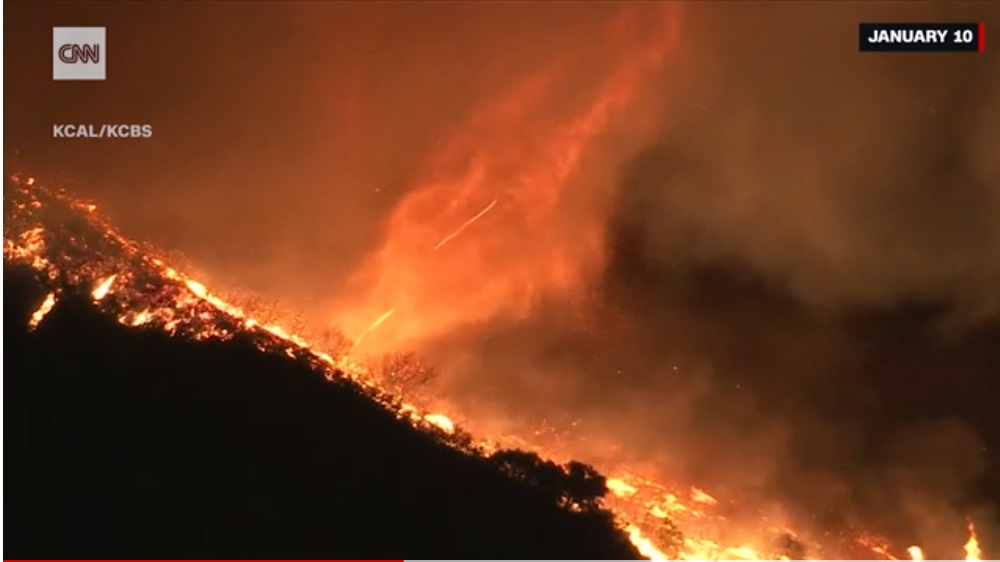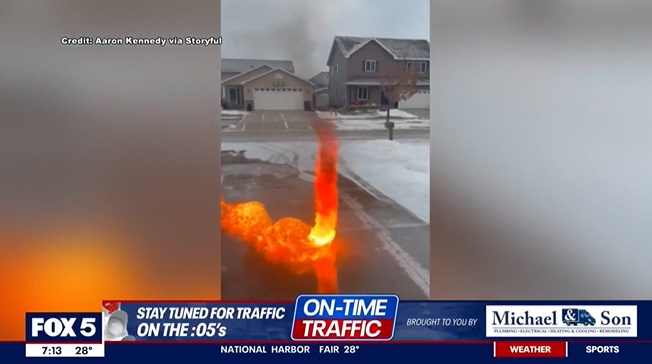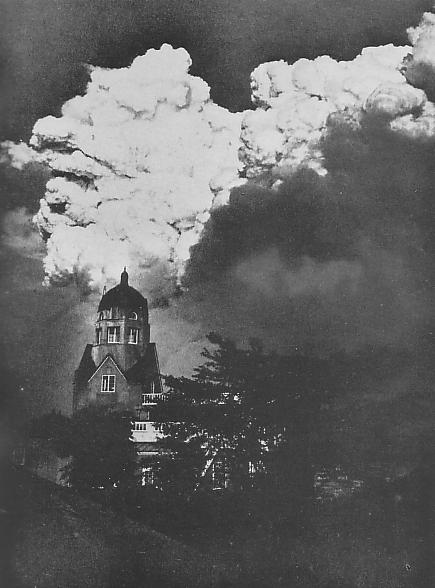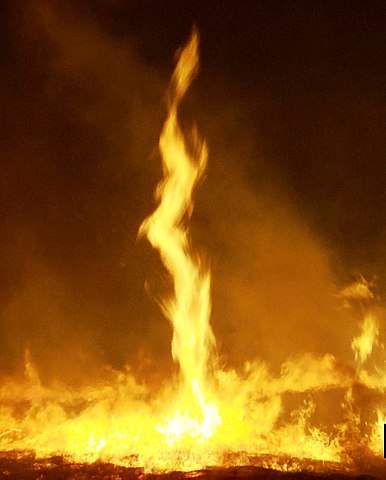Imagine a wildfire raging across a landscape. Suddenly, a twisting vortex of flame erupts from the inferno, reaching high into the sky. This is a fire whirl, a terrifying yet fascinating phenomenon that combines the destructive power of fire with the whirling fury of a tornado.
While often nicknamed “fire tornadoes” or “firenadoes,” fire whirls are distinct from their meteorological counterparts. This blog post will delve into the formation and behavior of fire whirls, exploring their similarities and differences with tornadoes.
 Firenado spotted in Los Angeles during the 2025 California wildfires. Source: CNN
Firenado spotted in Los Angeles during the 2025 California wildfires. Source: CNN
How Fire Whirls Form
Firenadoes are born from a complex interplay between heat, wind, and combustion. Here’s a breakdown of the key ingredients:
Intense Heat
A fire whirlwind requires a strong heat source, typically from a large wildfire or controlled burn. The heat rapidly rises, creating a powerful thermal updraft.
Rising Air
The hot air column creates a low-pressure zone at its base. This low pressure draws in surrounding cooler air, initiating a swirling motion.
Wind and Turbulence
Existing wind conditions can influence the rotation of the firenado. Additionally, surface features like canyons or changes in vegetation can create turbulence, further intensifying the whirl.
Combustible Material
As the air spins, it draws in smoke, embers, and even burning debris. This influx of combustible material feeds the flames, creating a visible vortex of fire.
The size and intensity of firenadoes vary greatly. Small firenadoes, sometimes called “fire devils,” can be just a few feet tall. For example, look at this tiny fire whirl captured by meteorologist in winter while burning away ice from driveway (a video is available here):

However, under extreme conditions, these whirling infernos can reach hundreds of feet in height, rivaling the size of weak tornadoes.
Fire Whirl vs Tornado
While distinct in their origin, fire whirls share some characteristics with tornadoes:
- Vortical motion. Both involve a rapidly rotating column of air. This vortex can pick up debris and propel it with destructive force.
- Low-pressure zone. The rising hot air in a whirling fire creates a low-pressure zone at its base, similar to the pressure drop at the funnel base of a tornado.
- Destructive potential. Both fire whirls and tornadoes can cause significant damage. Firenadoes can spread flames rapidly, while tornadoes can uproot trees, demolish structures, and even throw objects through the air.
And here are the key differences between an “ordinary” tornado and a “firenado”.
| Tornado | Firenado | |
|---|---|---|
| Origin | Severe thunderstorms | Thermal wildfire updraft |
| Driving Force | Interaction of warm, moist air with changing wind speeds and directions | Rising hot air |
| Rotation Source | Mesocyclone within the storm | Rising hot air |
Largest Fire Tornado Ever Recorded
Identifying the biggest firenado ever is tough, but one of the largest was the huge twister that formed during Tokyo’s 1923 Great Kantō earthquake. This devastating earthquake triggered widespread extreme fires, and the resulting inferno is believed to have produced a gigantic firenado.
Estimates suggest this whirling inferno reached an unimaginable size, reaching hundreds of feet in height and spanning kilometers in diameter. Its intense heat and violent winds may have caused the tragic deaths of up to 38,000 people in just 15 minutes.
 Source: Wikipedia
Source: Wikipedia
The Fiery Fury: Fire Whirl Dangers
Firenadoes pose a significant threat during wildfires. Their unpredictable nature and intense heat make them extremely dangerous. The strong winds within a firenado can quickly spread flames and embers, impacting the wildfire behavior. Moreover, unlike tornadoes, which often follow a predictable path, fire whirls can change direction rapidly, making them difficult to escape. Finally, the swirling flames can reach incredibly high temperatures, posing a serious risk to firefighters and anyone caught in its path.
Wildfire Safety: Mitigating the Risks of Fire Whirls
 Source: U.S. Fish and Wildlife Service; cropped by Beyond My Ken (talk) 00:25, 17 September 2015 (UTC), Public domain, via Wikimedia Commons
Source: U.S. Fish and Wildlife Service; cropped by Beyond My Ken (talk) 00:25, 17 September 2015 (UTC), Public domain, via Wikimedia Commons
While predicting the exact formation of firenadoes is challenging, some preventive measures can be taken:
- Fire management. Controlled burns conducted under controlled weather conditions can help minimize the risk of intense, fast-spreading wildfires that create fire whirls.
- Firefighter awareness. Training firefighters to identify the signs of a developing firenado can help them take evasive action if necessary.
- Public education. Educating communities living in fire-prone areas about the dangers of fire whirls can empower them to stay informed and prepared.
Conclusion
Firenadoes are a stark reminder of the immense power and complexity of fire. Understanding their formation and behavior is crucial for mitigating their risks. By respecting the power of fire and taking necessary precautions, we can better manage wildfires and protect lives and property.






